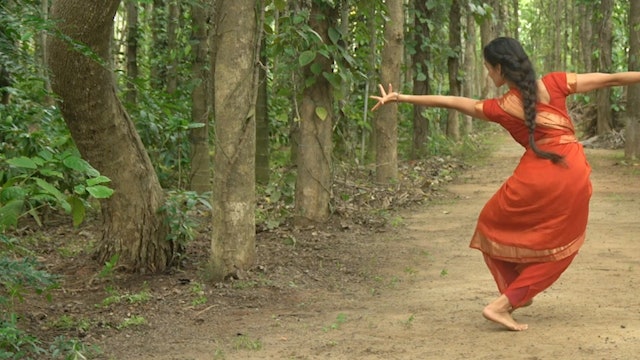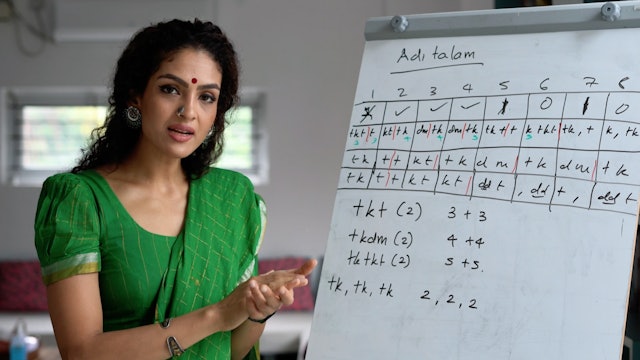-
Warm up : Isolations
The warm up changes in length and content as your body changes. What a conditioned body needs to warm up is very different than a body that is beginning this journey. This warm up is safe and helps a dancer at every level to find openness in the body. It can be done in combination with the hip op...
-
Legs and core 1
The first Strength regimen concentrates on two primary areas. The core and the legs. These two areas are necessary to move efficiently in a Bharatanatyam practice. The stabilisation of core muscles is necessary to move safely when dancing. This protects our back and helps with speed and clarity. ...
-
Naatadavu 3
The third Naatadavu stretches the leg out to the front. If you are unable to keep your back straight when doing this, please refer to the flexibility section and practice the tips for forward bends and try again.
-
Naatadavu 4
The 4th Naatadavu expects a little more stability in the body. Please practice any of the Strength sections that work on lunges and squats, to achieve a deep lunge in this Adavu.
-
Paraval Adavu 1
Paraval literally means to spread. Some schools of thought also call the Paraval adavu, the 'Pakkadavu' as it moves to the side while sliding. Some others change the name based on the way the foot articulates with the floor. A few of the types of Paraval, can be referred to as Marditam adavau, as...
-
Kudiita Thattaduvu
Pointers for Kuditta Thattadavu:
Try to go down instead of hopping up each time you snatch onto your heels.
Keep dropping your tailbone and pushing your thighs back.
When you bend to the side, elongate your lower side, so the length of your top side and bottom side remain the same.
Do not push... -
Ta hata Jumtari ta Adavu
The "Ta hata jumtari ta" Adavu, is named after the syllables that are used in the practice of the Adavu. This practise is common amongst most lineages of Bharatanatyam.
The Adavu is a combination of various movements. It has the 'di, di tai" action with the Tattu and Naatu, from the muktaya ada...
-
Aramandi Tips 1
This series will deal with a number of exercises that will work with developing a strong and stable Araimandi. It will also help resolve issues with knee and ankle pain. It must be practised in combination with the Hip openers and Leg strength for maximum benefit.
-
Aramandi Tips 2
This series will deal with a number of exercises that will work with developing a strong and stable Araimandi. It will also help resolve issues with knee and ankle pain. It must be practised in combination with the Hip openers and Leg strength for maximum benefit.
-
Mandi 1st speed
The Mandi Adavu gets it's name from the movement that involves the knee being placed on the ground alternately.
It is very important to do the exercises that strengthen the legs substantially and do all the exercises for Araimandi for a long period of time before embarking on this Adavu.
Boun...
-
Bramari Adavu
Bramari literally means to turn. The first Bramari adavu is introduced in the second set of Adavus, the other varieties will be introduced subsequently. It is important to keep the eyes focussed at a particular point and turn the head faster than the body.
Things to keep in mind:
- When stretc... -
Kartharee Adavu 1
The Kartharee adavu is a movement that begins with a jump, followed by the crossing of the legs. The name could come from the hasta that is used or from the fact that the legs cross.
The bends of the bodies vary in the various types of Kartharee adavu. We usually practice this Adavu to a three ...
-
Serikal Adavu
"Serikal", means to slide. This series of Adavus include a variety of sliding movements in the Adavu series of The Raadha Kalpa Method. The first variety is introduced in this series. Technically 'Jaaru' and 'Serikal' mean the same thing, but we will call this second series of sliding Adavus as '...
-
Adi Tala Korwe 1
Please watch the first three lectures on Talam before beginning the Korwe series. There is an instruction video for each Korwe.
A Korwe is a set of adavus that are formatted to a specific rhythmic structure, ending with a Muktayam/Teermanam adavu and layered on a Swara like in a Jatiswaram or Ta...
-
Adi Tala Korwe 2
Please watch the first three lectures on Talam before beginning the Korwe series. There is an instruction video for each Korwe.
A Korwe is a set of adavus that are formatted to a specific rhythmic structure, ending with a Muktayam/Teermanam adavu and layered on a Swara like in a Jatiswaram or Ta...
-
Adi Tala Korwe 3
Please watch the first three lectures on Talam before beginning the Korwe series. There is an instruction video for each Korwe.
A Korwe is a set of adavus that are formatted to a specific rhythmic structure, ending with a Muktayam/Teermanam adavu and layered on a Swara like in a Jatiswaram or Ta...
-
Tishra Eka Korwe 1: Instructions
Please watch the first three lectures on Talam before beginning the Korwe series. There is an instruction video for each Korwe.
The Korwe series continues with a variety of Talams. This is the first Korwe you will learn in Tishra Eka Talam.
Try to notice the difference in the rhythmic cycle as...
-
Tishra Eka Korwe 1
Please watch the first three lectures on Talam before beginning the Korwe series. There is an instruction video for each Korwe.
The Korwe series continues with a variety of Talams. This is the first Korwe you will learn in Tishra Eka Talam.
Try to notice the difference in the rhythmic cycle as...
-
Tishra Eka Korwe 2: Instructions
Please watch the Talam lectures upto Lecture 5 before beginning this korwe. There is an instruction video for each Korwe.
The Korwe series continues with a variety of Talams. This is the second Korwe you will learn in Tishra Eka Talam.
Try to notice the difference in the rhythmic cycle as you ...
-
Tishra Eka Korwe 2
Please watch the Talam lectures upto Lecture 5 before beginning this korwe. There is an instruction video for each Korwe.
The Korwe series continues with a variety of Talams. This is the second Korwe you will learn in Tishra Eka Talam.
Try to notice the difference in the rhythmic cycle as you ...
-
Lengthening Gluteals
When you do a lot of squats and lunges, the muscles in your buttocks tend to become tight. When this happens, it can lead to pain in your knee and also limit mobility in the hip joint.
It is important to frequently spend time on lengthening the muscles in your buttocks.
-
Hamstring help
A quick modification to the normal hamstring stretch to help you get aligned. You can do this either before or after practice, to help you lengthen your hamstrings.
-
Talam: Lecture 4 ,Saptatalas and Jathis
The lecture deals with the notations and idea of Jathis when applied to the Laghu in the Suladi Saptatalas, according to the Carnatic music tradition.
-
Talam: Lecture 5, Speed and notation
It is important to write Korwes and Jathis coherently such that you can understand when reading them subsequently. This lecture suggests ways in which you can begin to create a system of notation for yourself.

























